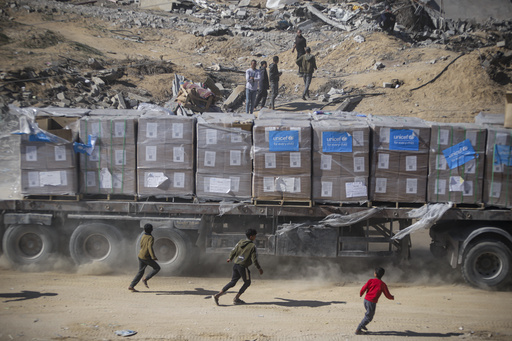
JERUSALEM — Following a ceasefire established two weeks ago between Hamas and Israel, aid is increasingly making its way into the Gaza Strip. This influx provides much-needed relief to a region devastated by hunger, widespread displacement, and destruction from 15 months of conflict.
However, Palestinians and aid organizations emphasize that there are significant challenges ahead to ensure that this assistance reaches those who need it most. Moreover, there are serious concerns about the possibility of renewed fighting should the ceasefire falter after its initial six-week duration.
As part of the ceasefire agreement, Israel has committed to allowing 600 aid trucks to enter Gaza each day, marking a significant boost from previous levels. Official estimates indicate that since the ceasefire began, at least 4,200 trucks have entered Gaza weekly.
Humanitarian groups note that the effectiveness of aid distribution is hampered by damaged infrastructure, Israeli inspections, and the danger posed by unexploded ordnance.
On Saturday, Samir Abu Holi, a 68-year-old resident, supervised a food distribution point in Jabaliya, a northern Gaza area that has been decimated by various Israeli military operations, leading to a halt in aid for over a month. “I have more than 10 children, and they all need milk and food. Before the ceasefire, it was very difficult to provide for them,” he shared. “Right now, there is a bit of relief.”
Examining the aid situation reveals a notable increase in support. According to the World Food Program, the principal U.N. agency for food aid, they distributed more food to Palestinians in the initial days of the ceasefire than in any comparable month during the hostilities. Over 32,000 metric tons of aid have entered Gaza since the halt in fighting began, as reported last week.
Aid is currently being delivered through two crossings in the north and one in the south. Various aid agencies are working to establish bakeries and distribute high-energy biscuits, with Hamas police taking to the streets to help maintain order.
Before the ceasefire, aid deliveries faced major complications due to looting by armed groups, assaults on aid workers, rigorous inspections by Israeli authorities, and coordination difficulties with COGAT, the Israeli military organization responsible for facilitating aid. Israel has pointed fingers at the U.N. and humanitarian organizations for their inability to distribute aid adequately within Gaza.
The recent pause in hostilities has led to what is termed a “political will to make everything else work.” Tania Hary, the executive director of Gisha—an Israeli organization advocating for Palestinian mobility rights—stated, “COGAT is expediting responses to requests for coordination, allowing two crossings in the north rather than just one to operate. The ceasefire permits Hamas forces to halt looting, and the absence of conflict helps aid agencies operate without risk.”
Despite the increase in aid, challenges remain with food pricing. Nadine Jomaa, a young resident of Bureij in central Gaza, shared that while aid is entering the region, purchasing goods in local markets remains a challenge due to inflated prices. The report from the World Food Program indicates that basic items like flour and cooking gas are still approximately three times their pre-war prices.
Jomaa’s family relies on cheap canned goods and she expressed a dire need for more food, clean water, and essential household items. While authorities have claimed that flooding Gaza with aid would diminish extortion, residents in the north have reported that the surge in supplies seems to favor elusive middlemen rather than directly reaching those in need.
Ahmed Qamar, 34, who has returned to the remnants of his home in Jabaliya, lamented the scarcity of aid trucks reaching his area. “Hundreds of families here are sleeping outside in the cold. We require electricity and shelter, yet the markets are overflowing with chocolates and cigarettes,” he noted.
Aid workers have recognized progress in the Israeli inspection process for aid delivery; however, certain essential supplies continue to face challenges entering Gaza. Some items are classified as “dual-use,” and there are concerns they might be utilized by militants for military purposes.
Many hospitals and water desalination facilities still face fuel scarcities, and Hamas has accused Israeli officials of obstructing the supply of vital medical and reconstruction equipment. According to information shared with humanitarian organizations by COGAT, many essential items, such as water collection devices and construction tools, need prior approval before being allowed into Gaza.
“Despite the increase in aid volumes, we are aware that restrictions on essential items remain,” stated Sophie Driscoll, head of communications for the International Rescue Committee in the Palestinian territories. While COGAT has acknowledged maintaining a list of dual-use items, they assert that allowing tents and other essential supplies into Gaza has recently become less restrictive, with thousands recognized as entering without limitation. COGAT also mentioned that crossing hours have been extended and that road repairs within Gaza are being facilitated.
“The distribution of aid within Gaza is not something Israel controls,” they added.
The destruction of road networks and the presence of unexploded munitions pose significant hazards within Gaza. The U.N. estimates that between 5% and 10% of the munitions dropped in the conflict could remain undetonated, creating a perilous environment for both civilians and aid workers.
UNMAS, the U.N. agency managing unexploded ordnance, confirmed that humanitarian convoys and civilians have reported uncovering large bombs, various grenades, and other munitions since the ceasefire began. As many Palestinians attempt to return to their homes, they find crucial water infrastructure has been destroyed, leading to increased risks of dehydration and disease related to poor sanitary conditions and limited healthcare resources.
Jonathan Crickx, communication chief at UNICEF, recalled witnessing dire conditions while traveling in southern Gaza, observing “thousands upon thousands of children and families” walking around with little more than the clothes on their backs.

